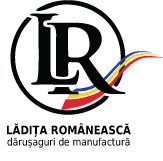The plate is made by Costel and Georgeta Popa, from Horezu, Valcea County. The Horezu pottery is unique in Romania and is known all over the world. Considered "a unique traditional craft", Horezu pottery has been included in UNESCO Intangible Cultural Heritage since 2012.
The clay is brought from the hills around the village and is prepared by a traditional technique. The clay is "leavened" for several weeks, while it is shred, watered and kneaded. When ready, the clay passes through several stages until it takes the shapes of the famous ceramic pots: molding on the wheel, first drying, angobing, second drying, ornamentation, third drying, first burning, glazing, second burning. The ornamentation is made with a cow horn bugle that has a goose feather on the top or with “gaița”, a thin pig hair brush. The traditional painting method called "jirăvire" is a special technique and is done by connecting the edges of a spiral with its...
The plate is made by Costel and Georgeta Popa, from Horezu, Valcea County. The Horezu pottery is unique in Romania and is known all over the world. Considered "a unique traditional craft", Horezu pottery has been included in UNESCO Intangible Cultural Heritage since 2012.
The clay is brought from the hills around the village and is prepared by a traditional technique. The clay is "leavened" for several weeks, while it is shred, watered and kneaded. When ready, the clay passes through several stages until it takes the shapes of the famous ceramic pots: molding on the wheel, first drying, angobing, second drying, ornamentation, third drying, first burning, glazing, second burning. The ornamentation is made with a cow horn bugle that has a goose feather on the top or with “gaița”, a thin pig hair brush. The traditional painting method called "jirăvire" is a special technique and is done by connecting the edges of a spiral with its center while the painting is still damp. The colors used are natural and are made of clay with iron or magnesium oxides. The most commonly used colors are brown, green, bricky and the famous Horezu ivory. The burning takes place in conical brick ovens with the large base down, by the oxidation technique in. The most popular motif used is the Hurez rooster, the symbol of the soul renaissance and immortality. He is drawn from the profile, with his head raised and his tail opened. Other motifs are the tree of life, symbolizing the union of heaven and earth, the spiral of life - the eternal cycle of birth, death and rebirth, the snake of the house - the guardian of the house, the fish - the symbol of Christianity, the peacock tail - the symbol of the eternal divine protection.
Wiping with a soft wet cloth or handwashing is recommended.
Ø 250-260 mm
*The products are handmade. Color, pattern, weight, shape and size may differ.
 View larger
View larger


